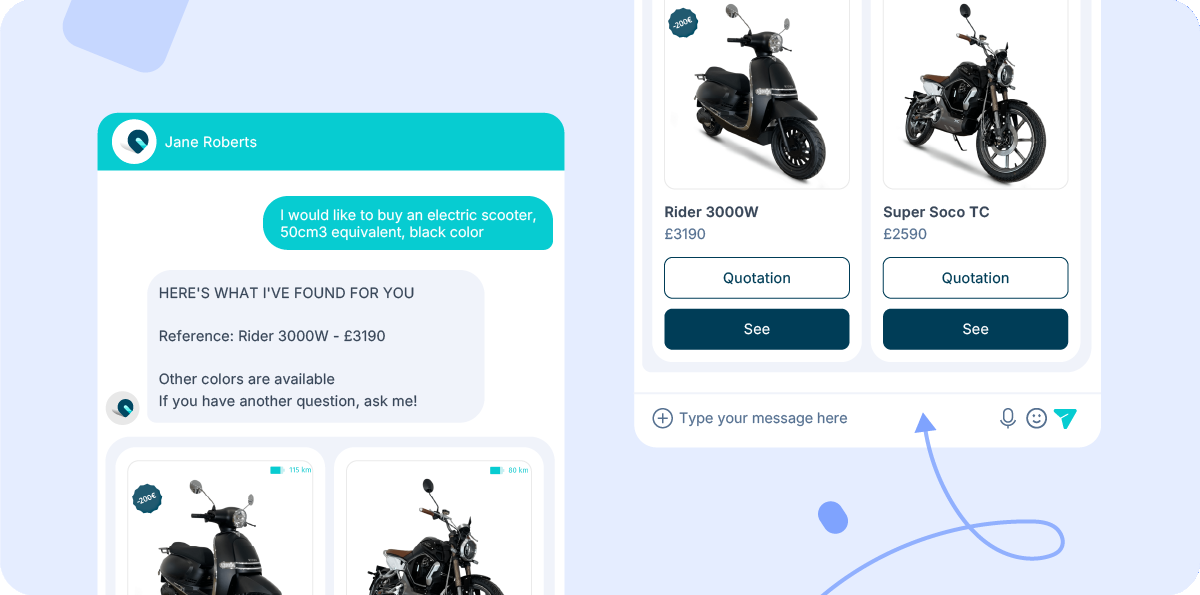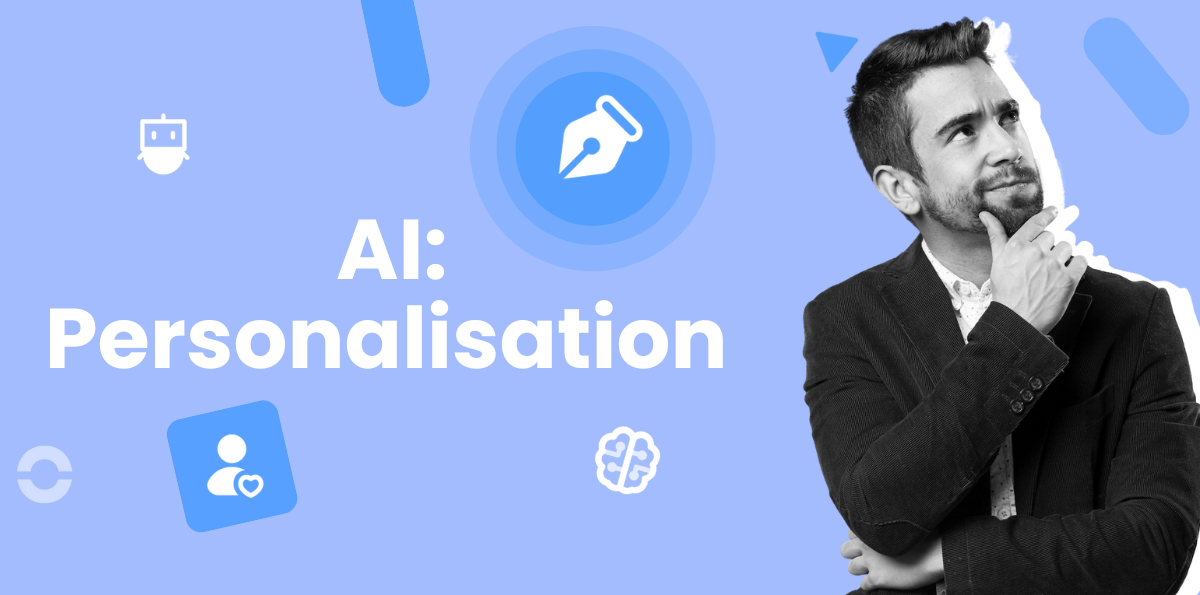Summary
- What is AI personalisation?
- How does AI personalisation work?
- Why is AI-driven personalisation gaining so much momentum?
- AI personalisation: what are the advantages?
- The advantages of AI personalisation for businesses:
- How can AI personalisation improve customer experience? What are the applications?
- AI and personalisation: challenges and best practices
- Trends in AI personalisation
- Predictive Analytics to Refine Communication Strategy
- Improve your customer experience now with an AI assistant
- What to remember about AI personalisation
- AI Personalisation FAQ
At a time when digital is establishing itself as the engine of business transformation, personalisation is one of the aspects not to be neglected. Companies must adapt to the demands of their clientele, which is more demanding, more volatile, more solicited.
Artificial intelligence (AI), in particular, offers unprecedented possibilities to redefine the way companies interact with their customers. Solutions like AI personalisation play the role of a catalyst, refining each interaction and bringing increasingly relevant responses to consumers' expectations.
However, all this does not happen with the snap of a finger. Challenges remain. What are they? Let's discover these challenges and explore examples, advantages, and best practices for integrating AI personalisation into your customer relationship processes.
What is AI personalisation?
Definition of AI personalisation
AI personalisation, or personalisation by artificial intelligence, is based on an approach founded on the in-depth analysis of customer data to offer experiences, services, and interactions truly adapted to each user.
The goal is to create unique moments, in line with the expectations and specific customer behaviours. This technology feeds on the impressive capabilities of AI, notably machine learning, to scrutinise and decode the preferences and habits of consumers across a multitude of channels and touchpoints.
Far from being content with basic segmentation, AI personalisation draws on multiple data types: demographic, behavioural, transactional, and psychographic.
Thanks to this wealth of information, it enables the delivery of tailor-made experiences, in real time, constantly adjusting messages and offers. This is what allows companies to move from a standardised approach to deeply individualised interactions, thereby strengthening customer satisfaction and, ultimately, loyalty to the brand.
How does AI personalisation work?
Behind the apparent fluidity of AI-personalised experiences lies a well-oiled mechanism, built around several essential steps. It all begins with data collection. This data, precious but raw, can come from multiple sources: websites, mobile apps, social networks, e-commerce platforms, CRMs, and many more. They form a raw material that AI will gradually shape.
Once centralised, this information is then processed through machine learning algorithms. This is the stage where the magic happens: AI identifies recurring patterns, detects implicit preferences, and decodes weak signals that sometimes escape classic human analysis. It is not a simple sorting process but a dynamic correlation of behaviours, contexts, and intentions.
This understanding relies mainly on machine learning techniques such as supervised learning—which uses labelled examples to make predictions—or unsupervised learning, when the goal is to discover groups or typical profiles without prior indication.
Reinforcement learning may also be used, where an algorithm refines its recommendations as it tests different actions and observes the results—somewhat like a system that learns through experimentation.
Why is AI-driven personalisation gaining so much momentum?
The answer is simple: AI personalisation is profoundly transforming how a company engages with its clients—not through fixed journeys or standard profiles, but via interactions tailored almost on demand at every moment.
By refining its responses throughout interactions, the AI assistant goes beyond simple answers: it anticipates, adjusts its speech, recognises implicit preferences, and aligns with expressed—or suggested—needs.
Such a resource proves more than relevant in a world where solicitations are constant, and where one must not only capture but also retain a prospect's attention.
Depending on the market, it can be difficult to offer something truly different from what competitors propose. The differentiating factor may come from AI and this increased personalisation. This is a new dynamic that should not be ignored to remain competitive.
Is hyper-personalisation the key to the future of customer relations?
Hyper-personalisation today goes beyond a trend and is gradually becoming an operational necessity. Far exceeding traditional customer segmentation, it allows marketing and customer relations professionals to enter into an almost individualised interaction logic, where every message, every offer, every product recommendation seems designed for a person—not for a customer category.
Concretely, this means the ability to adjust messaging in real time, based on weak signals emitted by the user—whether it's a purchase history, browsing behaviour, or even simple silence. This level of subtlety, impossible to achieve without the support of well-trained AI, redefines the standards of a successful customer experience.
👉 Today, investing in hyper-personalisation means investing in a long-lasting customer relationship—rooted in relevance and capable of withstanding the wear and tear of bland, generic messages.

AI personalisation: what are the advantages?
A smoother and more intuitive user experience
When well orchestrated, AI-based personalisation helps profoundly transform the customer experience. It makes customer journeys more natural, more relevant, and sometimes more enjoyable.
Tailored and genuinely useful recommendations
Take the classic example of product recommendations via email or a chatbot. Traditionally, they rely on fixed filters or broad categories. With AI, suggestions result from a dynamic cross-analysis between expressed preferences, past behaviours, and sometimes even implicit signals. Thus, the user spends less time searching—and more time discovering.
An ability to anticipate needs
The value of personalisation goes beyond the purchase. Thanks to continuous data analysis, companies can anticipate certain needs and adjust an offer before it's even formulated. This level of anticipation, often invisible to the customer, can nonetheless create a sense of closeness that's difficult to reproduce otherwise.
More relevant interactions through virtual assistants
AI-powered virtual assistants extend this logic: by adapting their responses to each user's profile, they establish more lively, more responsive dialogue.
Always available, never overwhelmed, they provide a reliable first level of response—capable of filtering, guiding, or reassuring—without ever breaking the flow of the conversation.
Less friction = more satisfaction
Finally, one often overlooked point shouldn't be underestimated: interaction comfort. A poorly calibrated, impersonal experience can irritate more than it informs. And the numbers confirm it: nearly seven out of ten customers say they feel frustrated when a company doesn't take into account their profile or history. In short, personalisation isn't just about convincing—it's also about retaining.
Provide customers with seamless and effective 24/7 service with Ringover’s AI Assistant, a powerful AI chatbot.
The advantages of AI personalisation for businesses:
A direct source of commercial growth
One of the first visible effects of AI personalisation is its impact on sales. By refining offers based on clients' expectations and preferences, companies encourage repeated, often more spontaneous and sometimes emotional purchases. This repetition creates attachment—a kind of bond with the brand that goes beyond mere value-for-money considerations.
Stronger loyalty through alignment
Offering each person an experience that resembles them—or at least feels designed for them—has become essential to establishing a lasting relationship. When a customer feels understood, they return—not just for the product, but for the perceived attentiveness in the interaction. This applies in B2C as well as in many B2B contexts, where differentiation now comes down to the details.
Controlled costs without sacrificing quality
AI reduces certain operational burdens. Automating low-value tasks—such as marketing campaigns, common responses, and segmentation—frees up human resources for areas where their input truly makes a difference. This time saving quickly translates into financial savings.
A competitive edge
As personalisation becomes embedded in processes, it becomes a marker of maturity. Companies that adopt it early gain a lead that's hard to catch up with. They create memorable experiences where others still settle for generic approaches. McKinsey quantified it: high-growth companies attribute up to 40% of their additional revenue to advanced use of personalisation.
Sharper, more actionable customer knowledge
Behind these visible benefits lies another deeper challenge: data quality. AI, when properly fueled, transforms data accumulation into usable intelligence. It allows companies to observe, compare, and understand. These insights refine not only marketing actions but also broader strategic decisions. Better knowing your clients also means better anticipating market shifts.
How can AI personalisation improve customer experience? What are the applications?
Continuous assistance through chatbots and virtual assistants
Smart chatbots are sometimes discreet but often remarkably effective. They are one of the most visible AI entry points in the customer ecosystem. Their promise: immediate answers, 24/7, to an ever-increasing number of requests. But beyond mere response automation, these assistants learn, adapt, and contextualise. They take into account history, preferences, and recent behaviours.
Personalised recommendations that anticipate need
Another area where AI excels: anticipation. By cross-referencing data from multiple sources—purchase history, browsing behaviour, stated or inferred interests—it can generate surprisingly accurate recommendations. It's no longer just about “suggesting a product,” but doing so at the right time, in the right context, without ever seeming intrusive.
This finesse in approach fundamentally changes the customer's perception. It makes the shopping experience not only smoother but more enjoyable.
A unified experience through omnichannel
AI plays a central role in creating real-time interactions that transcend channels. Imagine a client who browses a site, uses a mobile app, interacts on social media, and then goes to a physical store—while enjoying a perfectly consistent and personalised experience. That's where AI ensures this fluidity.
Whatever the chosen channel, AI ensures each interaction is contextual, relevant, and above all, aligned with customer expectations. Each touchpoint becomes an opportunity to strengthen the relationship—almost invisibly, but with formidable effectiveness.
The importance of automated feedback systems
AI also shines in the instant analysis of customer feedback. Thanks to automated feedback systems, companies can collect opinions in real time, analyse them, and respond without delay. It's no longer just about having feedback, but about being able to act quickly and effectively—adjusting actions based on every comment received.
This enables companies to stay on high alert—ready to refine their services and adapt immediately.
AI and personalisation: challenges and best practices
Using AI for personalisation offers many benefits, but also raises significant challenges that businesses must address. Here are the key challenges and best practices for maximising personalisation benefits while minimising risks.
Data quality: the foundation of successful AI personalisation
If there's one point that every AI-driven personalisation strategy depends on, it's data quality. No matter how sophisticated, an algorithm won't produce anything relevant from inconsistent, outdated, or incomplete data. Too often underestimated, this reality is nonetheless a prerequisite for any serious initiative. Inaccurate recommendations or out-of-context messages not only hurt commercial performance—they can also erode customer trust.
To address this, businesses would do well to establish strict data governance. This includes implementing regular cleaning, cross-validation, and source unification processes. Integrating a robust CRM and automating data flows between tools then become concrete levers to ensure information reliability and freshness.
Privacy and transparency: a balance to preserve
The rise of AI-based personalisation forces companies to walk a fine line: on one side, the promise of more engaging, tailor-made interactions; on the other, the need to uphold strict ethical and legal standards regarding personal data. This is not just a regulatory detail—it's a fundamental requirement shaping customer trust.
In practice, this means deploying proven security protocols and fostering educational transparency. Too often, privacy policies look like legal labyrinths. Yet in a context where customers are increasingly aware of data protection, it becomes essential to explain—clearly—what is collected, why, and what they can control.
Complying with regulations like the GDPR shouldn't be seen as a burden, but as an opportunity: to build a personalisation framework that respects individual freedoms while serving each client's specific needs.
Making artificial intelligence understandable: a strategic imperative
As AI becomes central in customer journeys, one demand becomes crucial: making the invisible visible. Algorithms—often seen as black boxes—can no longer just “work.” They must also “explain themselves.” Not in full technical detail, but in their decision logic, evaluation criteria, and built-in safeguards.
This explainability goes far beyond regulatory compliance. It touches the very core of the brand–customer relationship: trust. A system that personalises offers or prioritises requests without justifying its choices may eventually raise suspicion—especially if decisions seem incoherent or biased.
The question of reliability
Personalisation, if poorly calibrated, can quickly lose its value. What was meant to enhance the customer experience may then dilute or even irritate it. Too many repeated messages, off-target recommendations, or unwelcome insistence—and all your efforts can backfire.
That's why being precise isn't enough. You also have to be relevant—and above all, true to the identity you wish to project. Successful personalisation means message consistency and the enhancement of each interaction.
This requires fine-tuning, constantly. A/B testing helps measure what works instead of relying on intuition alone. And customer feedback—too often underestimated—provides essential insight into how experiences are truly perceived.
Integrate AI step by step: train teams to better personalise
Adopting AI in a personalisation strategy requires time, method, and above all, a gradual upskilling. Wanting to transform everything at once, without preparation, often amounts to chasing two hares at the same time... and missing both.
Effective implementation means “starting small”: a targeted use case, a well-defined application, a few well-utilised data points.
Then, as initial results are delivered, the integration can expand, refine, and gain in scope and coherence.
Humans remain at the heart of this transition. Without support, the best tools remain dead letters. It is therefore crucial to train teams, not only to handle these new solutions, but to understand the issues: how to interpret recommendations generated by algorithms, how to adjust parameters, how to react to potential deviations, etc.
Trends in AI personalisation
Current trends in AI personalisation mark a profound transformation in the way companies create content, interact with their customers, and leverage data. Here's an overview of the main trends that will redefine the future of AI personalisation.
Hyper-personalisation: a new era for tailor-made content
As the capabilities of algorithms progress, personalisation shifts into a new dimension. Far from classic approaches like inserting a first name in an email subject line or suggesting a product based on the last purchase, what is now called hyper-personalisation paves the way for interactions of unmatched refinement.
Soon, content will no longer just be addressed—it will feel written for the person, at the right moment. AI, now capable of adjusting not just the subject, but also the tone, duration, or even the channel of a message, will rely on a detailed mapping of each user's behaviour: browsing history, pace of past interactions, current interests, even presumed mood at a given time.
This level of granularity, which still seemed theoretical a few years ago, is gradually becoming an operational reality.
Automated content creation
Following the path of hyper-personalisation, another trend is emerging with increasing clarity: the intelligent automation of content creation. By 2025, it will no longer be just a technological asset, but a structural lever for companies seeking to maintain a consistent and coherent presence, without being held back by human production limits.
Generative AI tools will enable the production of varied formats in just moments: articles, explainer videos, newsletters, dynamic infographics, even narrative podcasts—all while respecting the brand's DNA. It's not just about volume: the strength of these solutions lies in their ability to adapt both substance and form to the target audience, the channel used, and the chosen moment. The message, though automated, can still carry an almost human resonance—if well guided.
This time saving, far from being a creative downgrade, could be a chance to restore strategy to its rightful place. Less absorbed by producing each piece of content, teams can refocus on objectives, narrative consistency, results analysis, and exploring new ideas.
Predictive Analytics to Refine Communication Strategy
Looking ahead to 2026, predictive analytics will no longer be limited to stock optimisation or risk management. It will become a cornerstone of communication strategies. Thanks to AI, brands will be able not only to understand what their audiences think today, but more importantly, anticipate how they'll feel tomorrow.
Concretely, it will no longer just be about reacting to behaviours, but detecting weak signals in advance: a growing interest in a specific topic, the emergence of new emotional expectations, or a gradual shift in focus areas.
This ability to anticipate will offer a clear advantage: adjusting your messaging precisely, or even positioning yourself before competitors have considered it.
Improve your customer experience now with an AI assistant
Give a new dimension to your customer relations with conversational AI: integrating an AI assistant into your communication ecosystem is no longer a luxury or costly investment, but a logical evolution for any company looking to streamline exchanges with its clientele.
Solutions like Ringover make this transition both accessible and tangibly beneficial.

A continuous, uninterrupted presence
The constant availability of an intelligent assistant changes the game. No more long waits outside office hours or delayed responses. An AI assistant, active 24/7, immediately handles simple requests, guides users, or redirects them to a human agent when necessary.
Let's take a concrete example: a customer calls outside opening hours. Instead of hitting an impersonal voicemail, they get an immediate answer to their query or can schedule a callback in seconds.
Interactions tailored to each profile
Beyond availability, it's the quality of interaction that makes the real difference. Thanks to the analysis of available data—call history, stated preferences, recurring behaviours—AI adjusts its speech. It doesn't just respond quickly, it responds accurately.
With a good AI assistant, this ability becomes a true personalisation lever. You can, for example, automatically adapt the greeting message for a loyal customer or recommend a relevant offer based on previous purchases.
24/7 Assistance and Reduced Wait Times
AI assistants are available 24 hours a day, 7 days a week, providing continuous, uninterrupted support. This availability significantly reduces wait times, allowing customers to get quick answers to their questions and improving overall satisfaction.
For example, a chatbot integrated with Ringover can handle incoming calls and messages, respond to FAQs, and redirect customers to appropriate resources or a human agent when needed.

Interactions that evolve with each customer
Artificial intelligence no longer just responds: it learns, adapts, and refines exchanges with each new interaction. By continuously analysing data from previous calls, messages, or online behaviour, an AI assistant can adjust its speech for each customer. We're no longer talking about a simple automated service, but a truly personalised experience.
Anticipate expectations, prevent dissatisfaction
Thanks to predictive analysis, intelligent assistants detect weak signals like decreased contact frequency, changes in buying habits, etc., in order to act early before potential disengagement.
A good AI assistant lets you implement these preventive actions smoothly: automatic follow-ups, personalised messages, proposed solutions even before the customer expresses a need. A simple way to increase loyalty and reduce churn.
Automate the essential to focus on what matters
By automating repetitive tasks like ticket qualification, call routing, or responses to frequent requests, AI assistants lighten the load on teams. This allows your agents to focus on the most complex and sensitive cases.
A 360° customer view, directly in your tools
An AI assistant's efficiency also relies on its ability to connect with your existing tools. By integrating with your CRM, the assistant offers a complete view of each customer. All interactions are centralised, available in real time, and usable at every stage of the journey.
This smooth connection allows your teams to deliver consistent and responsive service, no matter the channel used. No more switching between tools: all relevant information is at your fingertips when you need it.
What to remember about AI personalisation
Artificial intelligence is redefining how brands design their campaigns, interact with audiences, and retain customers. By intelligently leveraging collected data and powerful algorithms, companies can now offer highly targeted, relevant experiences at every step of the customer journey.
This personalised approach not only boosts conversion rates, but also helps build strong, lasting relationships with customers. Tailored recommendations, smooth conversations via virtual assistants, real-time adapted content—each interaction becomes an engagement opportunity.
AI offers brands a competitive edge. Are you ready to take that step? Learn more about our AI Agent today.
AI Personalisation FAQ
How to incorporate AI personalisation?
- Personalising AI involves several key steps to ensure adapted and relevant customer experiences. Here are the main points to follow:
- Data Collection and Analysis: AI personalisation starts with collecting large amounts of data on customer behaviours, preferences, and interactions. These data come from various sources such as websites, mobile apps, social media, and CRM systems.
- Use of Machine Learning Algorithms: Collected data are analysed by machine learning algorithms that identify trends and patterns in user behaviour. Methods such as regression, association, clustering, and Markov chains are commonly used for this analysis.
- Segmentation and Profiling: Algorithms group users into segments based on similar characteristics and behaviours. This segmentation enables personalised experiences based on individual customer profiles.
- Triggering Personalised Experiences: Based on the insights gained, AI triggers personalised experiences in real time. This can include product recommendations, adapted content, and interactions via chatbots or virtual assistants.
- Continuous Optimisation: AI continues to learn and adapt to user behaviours over time, constantly improving the relevance and effectiveness of personalised experiences.
What are the tools for AI personalisation?
There are several tools and technologies that support AI personalisation. Here are some of the most common:
- Chatbots and Virtual Assistants: These tools use AI to provide natural language interactions and personalised responses to customers. They can handle customer service queries, offer product recommendations, and help with issue resolution.
- Recommendation Engines: These systems use machine learning algorithms to suggest products or services based on past customer behaviours and preferences. Platforms like Amazon and Netflix use these engines to enhance user experience and increase sales.
- Marketing Automation Platforms: These platforms integrate AI to automate marketing campaigns and personalise messages based on customer data. They allow targeted campaigns to be launched and their effectiveness measured in real time.
- Customer Relationship Management (CRM) Systems: AI-integrated CRMs help centralise customer data and analyse interactions to offer personalised experiences. They allow businesses to manage customer relationships more efficiently and make informed decisions.
- Natural Language Processing (NLP) Tools: NLP is used to analyse and understand human language, allowing chatbots and virtual assistants to respond more humanly and pertinently to customer queries.
- Machine Learning Algorithms: Supervised, unsupervised, and reinforcement algorithms are used to analyse data and predict customer behaviors. They are essential for creating accurate and effective personalisation models.
Published on May 20, 2025.



